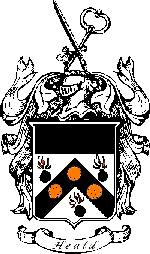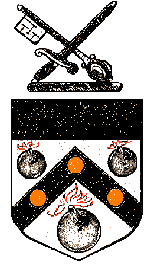- The 'firebombs' coat of arms
- Arms of James Heald, later MP (1829)
- Arms of George Heald, KC (d. 1834), and/or George Trafford Heald (1849)
- See also: Posting by Bill Heald on the Heald family discussion board at Genforum; and the various replies to it.
Arms: Argent, on a chevron between three bombs sable, fired proper, as
many bezants, a chief of the second.
Crest: A sword and key in saltire proper.

| 
| 
|
The description above is taken from Burke's General Armory (3e, 1844). It also appears thus in the 1884 edition, and in Papworth's Ordinary of Arms (1961), p.535. The description of the crest also appears in Fairbairn's Book of Crests (4e, 1905), from where the central illustration is taken.
Bill Heald quotes a slightly
different description of the shield:-
[A white or silver shield; with, on a red chevron between three black bombs (grenades) on fire in natural colours, the same number of gold discs; the upper third of the shield in the same red as the chevron].
The sword and the bombs may indicate active military experience: someone ready to fight with a sword, or put themself at the receiving end of bombs. The key and the bezants suggest a trustworthy custodian: someone who would be safe with keys, or the gold coins of a treasury.
The right-hand illustration (taken from RW Heald's healdfamily.org website) is adapted from a historic family quilt (date unknown) inherited from his grandmother. The full quilt design includes a date, 1641, but this date more probably commemorates the founding of Concord, Mass, by a group including John Heald, from whom this branch of the family is descended.
Burke's Armory does not say when or to whom the arms were originally granted; and there is some debate as to which (if any) present-day Healds technically have the right to use them.
One suggestion is that the arms were granted to a James Heald, a relative of the Healds of Mobberley in Cheshire, at some time in the reign of James I (1603-1625); but that the grant was later purged in the time of Cromwell, along with grants to other Royalists. (See eg the Johannes Heald (1547) page in the rwheald database at Rootsweb, which cites Jack Wendal Heald; Rootsweb: larrypdx also suggests that a coat of arms was inherited by John Heald of Concord, but cites no source for this).
According to Bill Heald in the post cited above, it has also been suggested that it was originally a 'scribe and treasurer of Edward III' (reigned 1327-1377) who was first granted the arms. Bill is dubious about this, but it could be a reference to William del Helde, who according to de Leycester's History of Cheshire bought Heild Manor from one of de Leycester's ancestors in 1355, and in 1360 acted as clerk when some land in Mobberley was signed over to another of de Leycester's antecedants. However, in the absence of more positive evidence about a grant of arms, the attribution seems most likely to be a case of "rounding up the usual suspects".
Another suggestion is that the arms were first granted to (Sir?) Thurstan Heald, a relative of the Healds of Chorley in Lancashire, early in the reign of Henry VII (reigned 1485-1509); but I have no evidence for this as yet, nor any other mention of this Thurstan.
Whilst not wanting to put too much of a dampener on such speculation, it is worth mentioning that no Healds were important enough to appear (even by marriage) amongst the pedigrees and coats of arms collected in the heralds' visitations of Lancashire in 1533, 1567 (Flower's visitation), 1613 (St George's visitation) or 1664-5 (Dugdale's visitation) [Chetham Society, volumes lxxxi., lxxxii., lxxxiv., lxxxv., lxxxviii., xcviii., and cx.]
It is also possible that the original coat of arms was less elaborate: according the 'Hall of Names' company, the most ancient Heald coat of arms was a simple silver shield with three black fire bombs (ie without the black (or red) chevron, the gold bezants, or the black (or red) chief). However, HoN has a very mixed reputation on the net, so it is probably unwise to accept this as definitive.
Any more information would be greatly appreciated: who exactly were these arms granted to; when; and is there any evidence of their early use in the New World, or by any particular family of Healds in England ?
Arms of James Heald, later MP (1829)
Arms: Quarterly gu. and az. in the first and fourth quarters, an eagle with wings elevated or., in the second and third a fret of the last all over, a fesse arg. thereon between two crosses patée a rose of the first barbed and seeded ppr.
"A Grant of Arms was made in 1829 to James Heald of Parr's Wood in the Parish of Manchester, second son of James Heald of Portwood in Brinnington and of Waterside in Disley, Cheshire for himself and the other descendants of his said father."
The illustrations are from a tapestry (c.1850-1870), probably by Margaret or Mary, sisters of James Heald; and from the original deed of grant.
It is possible of course to read almost anything into heraldic symbols (and quietly ignore the rest); but given James Heald's strong Christian outlook, reflected in the motto, the presence of the eagle and the red squared-off crosses may represent Christian faith and especially evangelism. The red rose presumably stands for Lancashire. The golden frets are yet another form of cross. Often in heraldry they represent persuasion: the ability to knot together two different strands of thought; but they may also refer to James Heald's background as a mill-owner, weaving together different strands of cotton quite literally; which perhaps gives the motto an intriguing alternative subtext.
See also: James Heald's page in the heald_lf database at Rootsweb.
Arms of George Heald, KC (d.1834), and/or George Trafford Heald (1849)
"The monument to George Heald [in Horncastle Church, Lincolnshire] says George Heald armigery, that is he was able to bear arms, he had his own coat of arms. His coat of arms is on the left; on the other is the griffin, which was of his wife who was one of the Traffords...
"Interestingly I checked on the coats of arms and she was allowed coats of arms because she was a member of the Trafford family. I looked him up but I couldn't find him so I wrote to Garter King of Arms who was the chief advisor for the Monumental Brass Society. I described the arms, and he wrote back and said, 'No these are spurious, the man who had those had no right to bear arms', and yet it says armigery, he was entitled to bear arms. "
Source: A Tour of Horncastle Church by Ray Elliott
Arms: Argent, two bars engrailed and in Chief as many escutcheons gules, each charged with a Mullet of the Field.
Crest: An Eagle, wings elevated, argent, each charged with two bars engrailed, Gules, gorged with a plain collar and pendant therefrom and escutcheon also gules, charged with a Mullet argent.
Crest: Upon a mount vert a bundle of arrows fesswise, the points towards the dexter ppr., bound gu., thereupon an eagle with wings elevated erminois, in the beak a sprig of oak also ppr., the dexter claw resting on cross patée, as in the arms.
Motto: Mea gloria crux.



According to Bill Heald's post, a coat of arms was granted to George's son, George Trafford Heald, on 8 August 1849 (the very day after the trial for bigamy began of his wife, the infamous Lola Montez).
Bill gives the following description:
(On a silver shield, two horizontal red bars with an escalloped edge. In the upper part of the shield are two small red shields, each charged with a silver star.)
(A silver Eagle with it's wings elevated. Each wing is charged with two red bars as in the arms. Round it's neck is a red collar from which hangs a small red shield, charged with a silver star.)